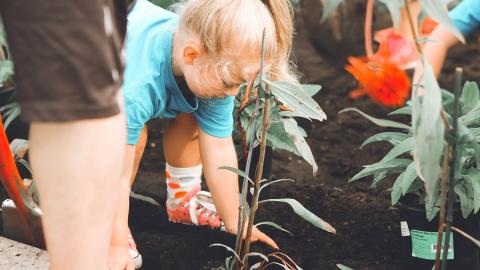Where are the seeds of faith first planted by the Holy Spirit? Within the family! Children first learn what it means to be a child of God by being part of a faith-filled family. That’s according to God’s plan—just read God’s instruction to the Israelites in Deuteronomy 6:6-7:
These commandments that I give you today are to be on your hearts. Impress them on your children. Talk about them when you sit at home and when you walk along the road, when you lie down and when you get up.
Admittedly the family God was talking about in this passage was much different than today’s family. The children of Israel thought of family in layers. First was one big family, all the descendants of Abraham. Families also belonged to a tribe, and within each tribe were clans—today we call this “extended family.” Finally there was the family itself—grandparents, parents, children—living together in the family compound. All parts of this layered Israelite community shared responsibility for raising the children, imparting values, and passing on the faith.
Today’s nuclear family, though, is still entrusted with passing on the faith. The church partners with the family in this process—in some ways taking on the role of the large extended family of biblical times.
Here are some ways for you, a teacher or leader in children’s ministry at your church, to help parents nurture the seeds of faith:
- Communicate with the parents of the children you teach. The more contact there is—by phone, letter, email, notes, personal visits, or informal chats at church—the more parents will consider you their partner in faith nurture. What a gift you are giving that family!
- Children’s learner resources in Dwell—Show and Share papers, Storymarks, or magazines—are another tool you can use to communicate. They’re great ways to encourage parents and pass along to them ideas for nurturing their children’s faith. Each unit of Dwell includes a letter to send families as you begin a new unit. Consider sending it in the mail with a personal note, or clipping to it a card with your contact information as you send it home with the children. In addition, there’s a set of God’s Big Story cards with suggestions for activities families can do to bring home the truth of each session.
- Look for other creative ways to communicate with families. One teacher called each parent at the beginning of the semester to introduce herself and share her hopes and dreams for the group. This initial family contact also gave her opportunities to find out more about her children’s fears and anxieties as well as their gifts and strengths. You could also set up an email list and send occasional updates on what’s happening in your group. Let parents know you’ll be praying for their children, and encourage them to contact you with questions or problems.
- Make it a priority to create a safe community in your classroom. Faith grows best when it is planted in good growing conditions. In the best families, children are accepted without reservation and treasured just as God cherishes them. Their unique abilities are affirmed; they are gently guided in behavioral expectations and offered forgiveness when they fail. Your classroom cannot replace a family’s total love and acceptance, but it can be a safe and sheltering place where each child dwells in God’s love and where the family’s love and teaching are reinforced.
- Tell your story. When families tell stories about things that are a part of their identity, children get a sense of family history and family values. Our hope is that children will want to be part of God’s big story, so sharing stories of your own faith walk—its joys and struggles, its hopes and, yes, its failures—communicates to children that they are part of a larger family, a community that shares its story too.
- Extend an invitation to visit your classroom. Aubrey Schneider, children’s director at Celebrate Community Church in Knoxville, Iowa, writes, “We held our first Family Festival in March where all of the kids’ families were invited to attend Kidzone on a Sunday morning. We had a skit, sang songs, had activities and contests . . . the families loved it. We had treats, balloons . . . very festive.” Aubrey figures she’ll do this twice a year as a treat for everyone. What an encouragement for parents to know that others are sharing in the care and the nurture of their children’s faith!
This post contains an excerpt from Dwelling. Reprinted with permission. © Faith Alive Christian Resources.

Let's Discuss
We love your comments! Thank you for helping us uphold the Community Guidelines to make this an encouraging and respectful community for everyone.